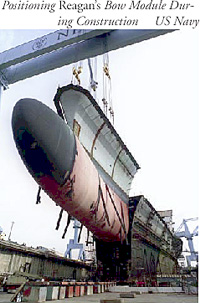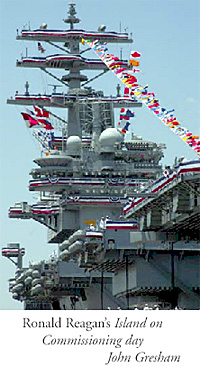 Ed Note: This material is extracted from the folder that was part of USS Ronald Reagan’s commissioning ceremony.
Ed Note: This material is extracted from the folder that was part of USS Ronald Reagan’s commissioning ceremony.
Ronald Reagan is a “transitional” aircraft carrier. She and the next carrier being built (CVN-77 – USS–George H. W. Bush) are going to be testbeds for new equipment and design features which will go into the new carrier hull design planned for the next decade. This means that while Reagan may look quite similar to other Nimitz-class carriers at dockside, the differences are many and varied.
Positioning Reagan’s Bow Module During Construction US Navy
Some of the 76 major changes include: Ronald Reagan has been given a bulbous bow extension below the waterline. This has the effect of lowering the drag of the hull, thus extending the life of the reactor cores and allowing more of the ship’s power to be diverted to operational/quality-of- life issues like more powerful air conditioning, catapult operation and more fresh water production. The flight deck has been modified slightly from that of previous Nimitz-class carriers. The landing angle has been increased by .15° and deck extensions have been added in several places around the deck edge. This small increase will allow the landing area on the angle to conduct landing operations while aircraft are being launched on both bow catapults. This has been a limitation when operating the F-14 Tomcat, E-2 Hawkeye and C-2 Greyhound, which have very wide wingspans. New single-panel jet blast deflectors are designed to provide improved protection for flight deck personnel. Also, small additions to the deck edge areas are allowing more flexible organization and execution of flight deck activities.
Finally, the number of arresting wires has been reduced from 4 to 3 (plus a barrier), along with redundant cross-connections between the arresting gear engines. The cables themselves have been strengthened, allowing for larger and more heavily loaded aircraft (up to 100,000 lb.) to be landed. This will allow greater “bringback” of valuable and expensive precision guided munitions (PGMs), along with giving aircraft designers a chance to design larger aircraft for carrier use.
Island
Though it looks the same, the island structure on Reagan is completely new. One whole level has been deleted, along with visibility on the navigation bridge and primary flight control (“Pri-Fly”) being extended to cover a 270° field of view. Overhead space has been increased by 9 inches on every level, as has total floor space. This will allow greater room for personnel in Pri-Fly and the bridge, along with significant growth potential for new equipment in the future. In addition, virtually every system has been automated, providing much greater control with far fewer personnel. At 650 tons, Reagan’s island is considerably lighter than that of the previous Nimitz-class ship, Harry S. Truman.
 Ronald Reagan’s Island on Commissioning day John Gresham
Ronald Reagan’s Island on Commissioning day John Gresham
Weapons Elevator
Perhaps the biggest change to the flight deck of Reagan has been the inclusion of a high-capacity weapons elevator in the aft end of the island structure. This covered elevator, which runs all the way to the lower magazines, is large enough to handle every kind of bomb, missile, external store, and other equipment that can be hung on a U.S. Navy or Marine Aircraft. Best of all, the elevator does this with the weapons/stores fully assembled, something previously impossible on American carriers. Now instead of having to leave live, assembled PGMs/weapons/stores exposed to the elements and threats on deck, they can be kept safely in the magazines until needed. This should greatly enhance safety and workflow efficiency on the flight deck, and provide the Air Department with even more room on deck.
Weapons
Reagan will be the first new flattop in more than two decades not to be equipped with the Mk15 Phalanx Close In Weapons System. Instead, she will carry a self-defense armament of two 8-cell Mk29 NATO Sea Sparrow launchers, along with a pair of 21 round Mk31 launchers for the new RIM-116 RAM missile. In addition, the Sea Sparrow launchers will be capable of accommodating the new RIM-162 Evolved Sea Sparrow Missile (ESSM) when it arrives in the fleet in a few years.
Ronald Reagan is the most automated aircraft carrier ever built, with computers, networks, routers, and servers connected to almost every system on the ship. There also have been a number of interior changes, which will translate into a somewhat different lifestyle for the crew. These include:
Accommodations
Reagan is the first carrier designed from scratch to accommodate women aboard ship. This includes grouping of female berthing/shower/head facilities for maximum efficiency. Many of these changes have actually been implemented for the men’s areas as well, including a variety of water-saving devices, better personal stowage space, and an expanded ship’s store to better supply personal needs aboard ship.
The combat system of Reagan will be the most integrated and complex of any ever deployed afloat. This includes the new Cooperative Engagement Capability (CEC) system, which uses high-speed data links to network all the ships of a battle group together. CEC can cue one ship to fire weapons at incoming threats like cruise missiles with firing data from another. Ronald Reagan will be the first carrier to commission with CEC installed, and should greatly enhance the defenses of the entire battle group that will be built around her. Reagan’s “main battery” will be built around the air wing. This will include a number of new types, either coming into service now or in the next few years. Already, accommodations have been made for the new F/A-18E/ F Super Hornet, and growth room has been set aside for the SH-60R. There also have been allowances made for the new F-35 Joint Strike Fighter when it arrives sometime in the next decade. UAVs and unmanned combat aerial vehicles (UCAVs) will also be a part of Reagan’s air wing during the next five decades, and have been planned for as well.
All of these improvements and changes, which have been incorporated into the design of Reagan, have radically altered the blueprints of this massive ship. However, even the blueprints, or more exactly, the production drawings, have been improved during the construction of Reagan. Seventy percent of the 12,000 drawings which make up the production package for a Nimitz-class carrier have been updated, and the final conversion of these to a computerized CAD/CAM system has been completed. Three-D product modeling has been used by Newport News Shipyard to test each major change, to ensure that the differences deliver the promised improvement without causing unanticipated problems. The result is a ship that may look like a production Nimitz-class carrier, but will be operated in some very different ways.
Current plans have Reagan moving to her new homeport of San Diego, California sometime in early 2005. Then Reagan will be ready to be added to the Pacific Fleet carrier rotation schedule, and begin her service to the nation. For the next half-century, this ship and the people who will man her will be the living symbols of American power overseas. It is an awesome achievement, though one made possible by the creativity and professionalism of the folks at across the James River at Newport News Shipbuilding. And as you read this, another metal mountain is beginning to take shape in Drydock 12: George H.W. Bush (CVN-77). The cycle begins again.
BT
Back to The Naval Sitrep # 25 Table of Contents
Back to Naval Sitrep List of Issues
Back to MagWeb Master Magazine List
© Copyright 2003 by Larry Bond and Clash of Arms.
This article appears in MagWeb.com (Magazine Web) on the Internet World Wide Web.
Other military history and related articles are available at http://www.magweb.com